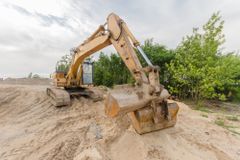Why You Should Use Ground Penetrating Radar Before Construction

Construction work heavily relies on project schedules, and unforeseen delays can have costly repercussions. Many setbacks lie beneath the surface; the unexpected discovery of buried structures, sinkholes, and underground utilities can halt ongoing works. Fortunately, you can avoid subsurface surprises with ground penetrating radar before starting construction.
Why Opt for GPR Scanning
A ground penetrating radar transmits high-frequency radio waves into the ground to create images of the subsurface, locate buried objects, and identify structural instabilities underground. It’s much less intrusive and disruptive compared to other methods like site excavation.
Requires Minimal Work & Noise
GPR scanning only needs a skilled operator and proper equipment. Depending on the area to be inspected, GPR scanning takes less time and effort while covering significantly more ground underneath than other probing techniques. It provides a more accurate picture of the subsurface area as well. Moreover, ground penetrating radar units operate quietly so they won’t add to noise pollution or cause a disturbance.
Avoid Problematic Situations
Before GPR scanning, engineers had to rely on schematics or excavate the ground to determine what’s underneath. Both methods, however, can be troublesome—schematics are not always comprehensive and may exclude changes that occurred over the years. On the other hand, excavating a problematic site, such as one with loose soil, fractures, voids, or sinkholes, risks injury to construction workers and damaging equipment.
Lower Costs
GPR scanning is a cost-effective solution that gives an accurate, detailed picture of the subsurface. By knowing the problems beforehand, construction companies are better prepared to address the issues without affecting project costs.
What Could Happen If GRP Isn’t Used Before Construction Begins
Despite the benefits  of ground penetrating radar, some companies fail to realize the importance of this technology for a site inspection. Without GPR scanning, they’re unable to accurately identify what’s underneath the surface. They’re therefore more likely to destroy underground tanks and utilities like cables and pipes, especially if they choose to excavate without proper surveying. For instance, damaging a septic tank, sewer pipe, or gas line during excavation can quickly contaminate the surrounding soil, leading to health hazards and the need for extensive repairs and even costly legal fees.
of ground penetrating radar, some companies fail to realize the importance of this technology for a site inspection. Without GPR scanning, they’re unable to accurately identify what’s underneath the surface. They’re therefore more likely to destroy underground tanks and utilities like cables and pipes, especially if they choose to excavate without proper surveying. For instance, damaging a septic tank, sewer pipe, or gas line during excavation can quickly contaminate the surrounding soil, leading to health hazards and the need for extensive repairs and even costly legal fees.
Schedule a ground penetrating radar scanning with Haggith’s Structural Scan & Inspection before starting a construction project. Based out of Honolulu, HI, Dale Haggith and his team specialize in non-destructive inspection services such as GPR scanning and electromagnetic surveys to accurately identify obstructions and utilities underground. Call (808) 239-4330 to request a quote, or visit their website to learn more about subterranean imaging.
About the Business
Have a question? Ask the experts!
Send your question

